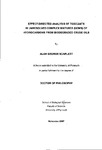Effect-directed analysis of toxicants in unresolved complex mixtures (UCMs) of hydrocarbons from biodegraded crude oils
| dc.contributor.author | Scarlett, Alan George | |
| dc.contributor.other | School of Biological and Marine Sciences | en_US |
| dc.date.accessioned | 2013-10-03T09:10:48Z | |
| dc.date.available | 2013-10-03T09:10:48Z | |
| dc.date.issued | 2007 | |
| dc.identifier | NOT AVAILABLE | en_US |
| dc.identifier.uri | http://hdl.handle.net/10026.1/1979 | |
| dc.description | Merged with duplicate record 10026.1/686 on 14.03.2017 by CS (TIS) | |
| dc.description.abstract |
Contamination of the environment by petrogenic hydrocarbons continues to pose a threat to marine biota. Studies into the effects of hydrocarbon contamination have mainly been directed at a small number of polycyclic aromatic hydrocarbons (PAHs) that are known to be highly toxic to a wide range of biota. The majority of the hydrocarbons present in sediments and tissues are unresolved by conventional gas chromatography and have received little attention. Studies directed at these unresolved complex mixtures (UCMs) of hydrocarbons have previously identified the monoaromatic fraction as containing toxic UCM compounds. The studies reported herein have explored the toxicity of UCM compounds to marine biota using an effect-directed analysis approach: (i) population-level effects on the amphipod Corophium vo/utator arising from chronic exposure to UCM hydrocarbon contaminated sediments; (ii) bioaccumulation and depuration of UCM hydrocarbons by the blue mussel, Mytilus edulis using comprehensive two-dimensional gas chromatography coupled to time-of-flight mass spectrometry (GCxGC-ToF-MS); and, (iii) the possible trophic transfer of UCM hydrocarbons from contaminated mussels to the predatory shore crab Carcinus maenas. Chronic sediment exposure tests showed that oils dominated by UCM hydrocarbons reduced the growth rate and reproductive success of C. volutator. All fractions of the oils contributed towards the toxicity but the aromatic fraction produced effects at lower nominal sediment concentrations. The aromatic fraction was also responsible for the reduction of mussel filter-feeding clearance rates. Analyses of mussel tissue extracts by GCxGC-ToF-MS revealed that a range of aromatic compounds was rapidly accumulated, but most were readily depurated. Compounds that were more resistant to depuration, including branched alkylbenzenes (BABs), were also found in wild mussel populations previously reported to have poor health status. Tests using a commercially available complex mixture of C12.14 BABs confirmed that these compounds were toxic to mussels and were not readily depurated. Crabs that consumed mussels contaminated with BABs were found to behave abnormally, but cellular and physiological effects were not significantly different to control organisms. Crab midgut gland tissues were found to contain low concentrations of BABs and fluorescence from urine suggested that the BABs were metabolised and/or excreted. The results did not support the hypothesis that BABs were likely to biomagnify within the marine food web. The research reported herein supports the hypothesis that environmental UCMs are largely comprised of branched alkylated homologues of known petrogenic hydrocarbons. Of these, the BABs have been shown to bioaccumulate and cause adverse effects via a non-specific narcosis mode of action. Marine environment monitoring and regulatory bodies may benefit from taking into account the concentrations of UCM hydrocarbons, in particular the aromatic UCM, including the BABs. | en_US |
| dc.language.iso | en | en_US |
| dc.publisher | University of Plymouth | en_US |
| dc.title | Effect-directed analysis of toxicants in unresolved complex mixtures (UCMs) of hydrocarbons from biodegraded crude oils | en_US |
| dc.type | Thesis | |
| plymouth.version | Full version | en_US |
| dc.identifier.doi | http://dx.doi.org/10.24382/3678 | |
| dc.identifier.doi | http://dx.doi.org/10.24382/3678 |
Files in this item
This item appears in the following Collection(s)
-
01 Research Theses Main Collection
Research Theses Main


